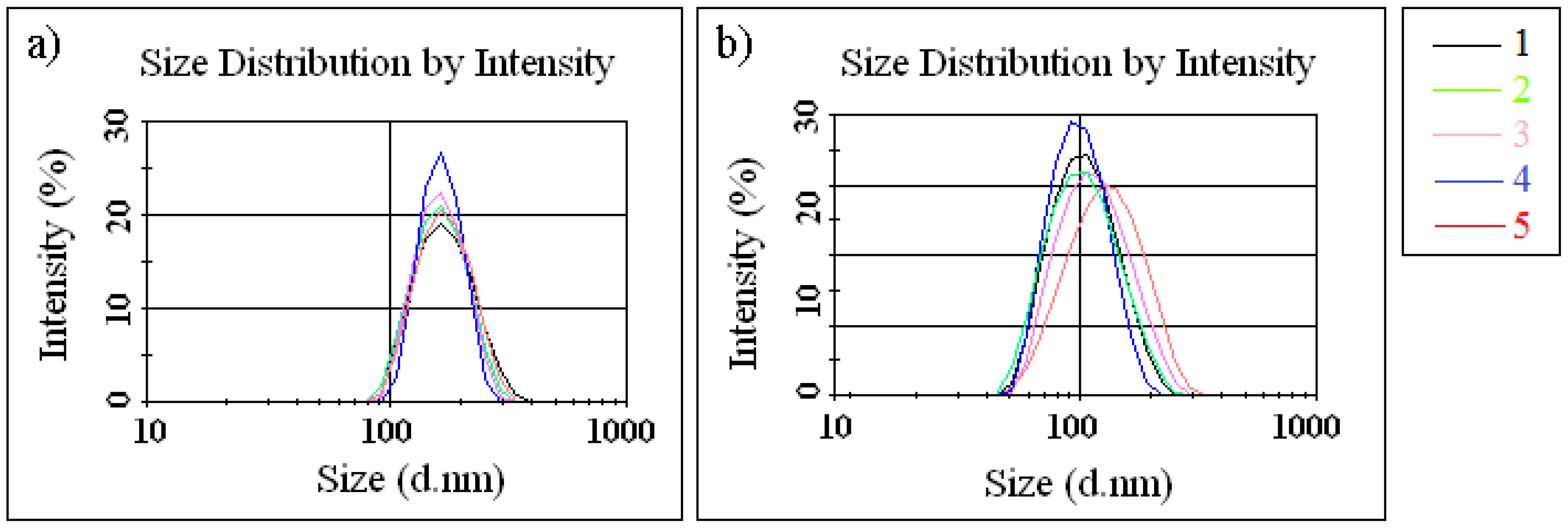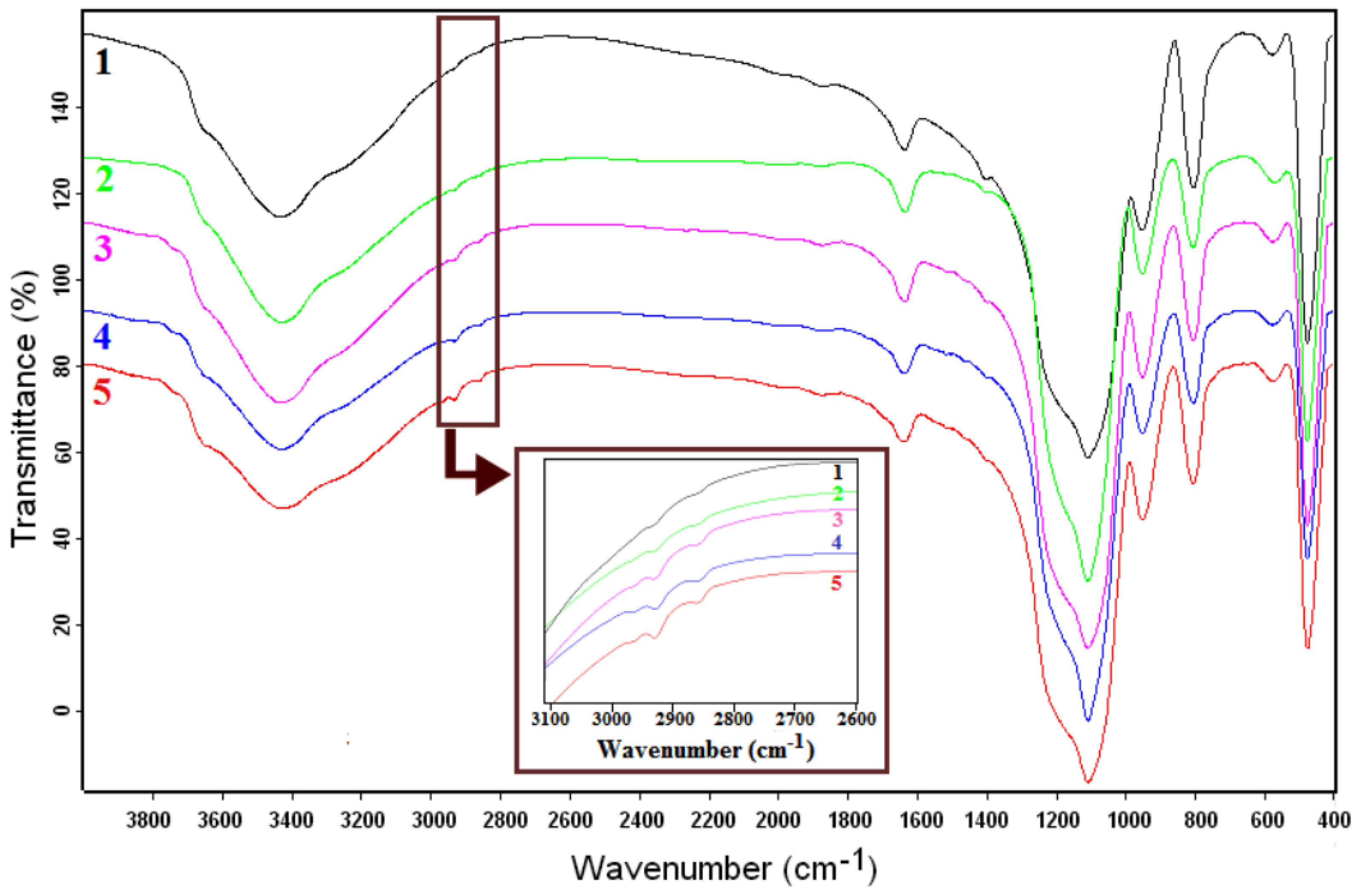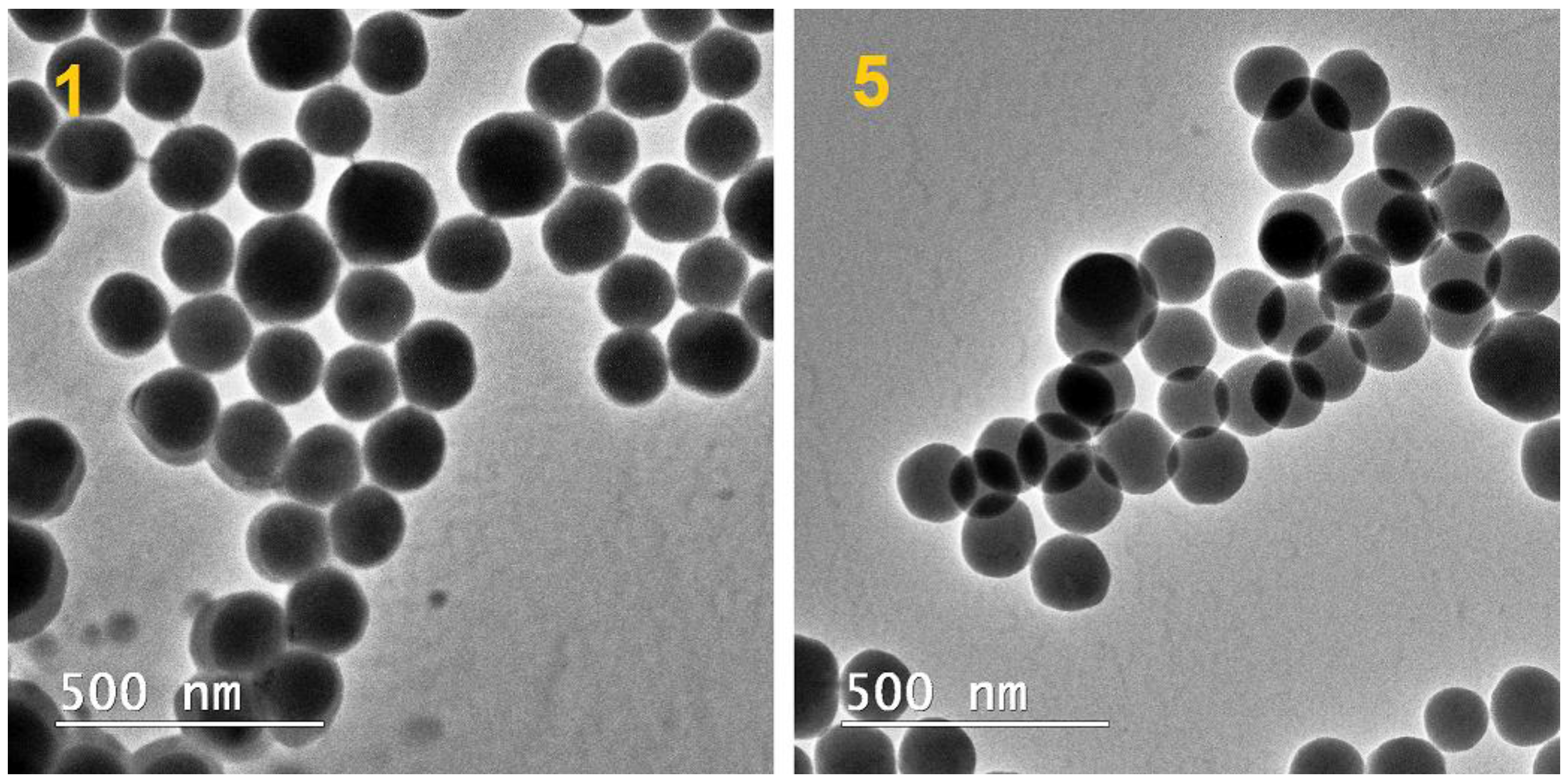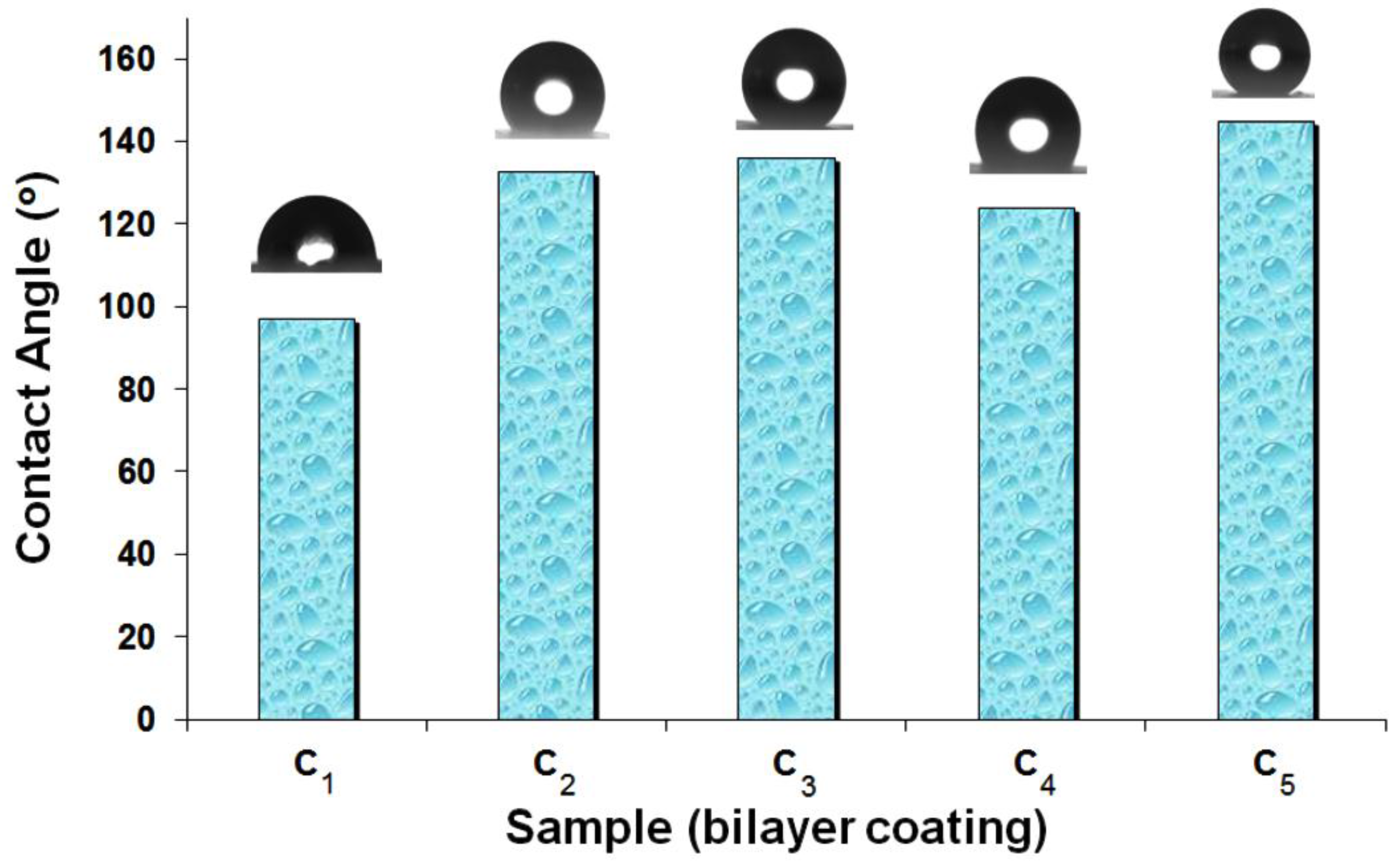The Influence of New Hydrophobic Silica Nanoparticles on the Surface Properties of the Films Obtained from Bilayer Hybrids
Abstract
:1. Introduction
2. Results and Discussion
3. Experimental Section
3.1. Materials
3.2. Preparation of Silica Nanoparticles (SiO2 NPs)
3.2.1. Synthesis of the Pristine Silica Nanoparticles
3.2.2. Functionalization of the Silica Nanoparticles with Various Mono-Alkoxy Derivatives
3.3. Fabrication of the Bilayer Coatings on the Glass Substrate
3.3.1. Preparation of the First Coating Layer
3.3.2. Preparation of the Second Coating Layer
3.4. Characterization Methods
4. Conclusions
Supplementary Materials
Acknowledgments
Author Contributions
Conflicts of Interest
References
- Roach, P.; Shirtcliffe, N.J.; Newton, M.I. Progress in Superhydrophobic Surface Development. Soft Matter 2008, 4, 224–240. [Google Scholar] [CrossRef]
- Ma, M.; Hill, R.M. Superhydrophobic surfaces. Curr. Opin. Colloid Interface Sci. 2006, 11, 193–202. [Google Scholar] [CrossRef]
- Feng, X.J.; Jiang, L. Design and creation of superwetting/antiwetting surfaces. Adv. Mater. 2006, 18, 3063–3078. [Google Scholar] [CrossRef]
- Gao, L.; McCarthy, T.J. How Wenzel and Cassie Were Wrong. Langmuir 2007, 23, 3762–3765. [Google Scholar] [CrossRef] [PubMed]
- Shimojima, A.; Kuroda, K. Designed synthesis of nanostructured siloxane-organic hybrids from amphiphilic silicon-based precursors. Chem. Rec. 2006, 6, 53–63. [Google Scholar] [CrossRef] [PubMed]
- Spataru, C.I.; Purcar, V.; Ghiurea, M.; Radovici, C.; Stanga, G.; Donescu, D. Effects of the nanoassociation of hexadecyltrimethoxysilane precursors on the sol–gel process. J. Sol-Gel Sci. Technol. 2013, 65, 344–352. [Google Scholar] [CrossRef]
- Nagappan, S.; Park, S.S.; Ha, C.S. Recent advances in superhydrophobic nanomaterials and nanoscale systems. J. Nanosci. Nanotechnol. 2014, 14, 1441–1462. [Google Scholar] [CrossRef] [PubMed]
- Li, L.; Li, B.; Dong, J.; Zhang, J. Roles of silanes and silicones in forming superhydrophobic and superoleophobic materials. J. Mater. Chem. A 2016, 4, 13677–13725. [Google Scholar] [CrossRef]
- Han, J.T.; Kim, S.Y.; Woo, J.S.; Lee, G.W. Transparent, conductive, and superhydrophobic films from stabilized carbon nanotube/silane sol mixture solution. Adv. Mater. 2008, 20, 3724–3727. [Google Scholar] [CrossRef]
- Wu, Z.; Han, H.; Han, W.; Kim, B.; Ahn, K.H.; Lee, K. Controlling the hydrophobicity of submicrometer silica spheres via surface modification for nanocomposite applications. Langmuir 2007, 23, 7799–7803. [Google Scholar] [CrossRef] [PubMed]
- Manoudis, P.; Karapanagiotis, I.; Tsakalof, A.; Zuburtikudis, I.; Panayiotou, C. Superhydrophobic composite films produced on various substrates. Langmuir 2008, 24, 11225–11232. [Google Scholar] [CrossRef] [PubMed]
- Kulkarni, S.A.; Ogale, S.B.; Vijayamohanan, K.P. Tuning the hydrophobic properties of silica particles by surface silanization using mixed self-assembled monolayers. J. Colloid Interface Sci. 2008, 318, 372–379. [Google Scholar] [CrossRef] [PubMed]
- Xiu, Y.; Zhu, L.; Hess, D.W.; Wong, C.P. Biomimetic Creation of Hierarchical Surface Structures by Combining Colloidal Self-Assembly and Au Sputter Deposition. Langmuir 2006, 22, 9676–9681. [Google Scholar] [CrossRef] [PubMed]
- Yilgor, I.; Bilgin, S.; Isik, M.; Yilgor, E. Tunable Wetting of Polymer Surfaces. Langmuir 2012, 28, 14808–14814. [Google Scholar] [CrossRef] [PubMed]
- Yang, T.; Tian, H.; Chen, Y. Preparation of Superhy-drophobic Silica Films with Honeycomb-Like Structure by Emulsion Method. J. Sol-Gel Sci. Technol. 2009, 49, 243–246. [Google Scholar] [CrossRef]
- Shang, Q.Q.; Gao, L.J.; Liu, H.; Xiao, G.M. Fabrication of Superhydrophobic Silica Film by Removing Polystyrene Spheres. J. Sol-Gel Sci. Technol. 2011, 59, 334–337. [Google Scholar] [CrossRef]
- Xu, D.; Wang, M.; Ge, X.; Lam, M.H.W.; Ge, X. Fabrication of raspberry SiO2/polystyrene particles and superhydrophobic particulate film with high adhesive force. J. Mater. Chem. 2012, 22, 5784–5791. [Google Scholar] [CrossRef]
- Petcu, C.; Nistor, C.L.; Purcar, V.; Cinteza, L.O.; Spataru, C.I.; Ghiurea, M.; Ianchis, R.; Anastasescu, M.; Stoica, M. Facile preparation in two steps of highly hydrophobic coatings onpolypropylene surface. Appl. Surf. Sci. 2015, 347, 359–367. [Google Scholar] [CrossRef]
- Purcar, V.; Cinteza, O.; Ghiurea, M.; Balan, A.; Caprarescu, S.; Donescu, D. Influence of the hydrophobic characteristic of organo-modified precursor on the wettability of silica film. Bull. Mater. Sci. 2014, 37, 107–115. [Google Scholar] [CrossRef]
- Purcar, V.; Cinteza, O.; Donescu, D.; Bala, D.; Ghiurea, M.; Petcu, C.; Caprarescu, S. Surface modification of silica particles assisted by CO2. J. Supercrit. Fluids 2014, 87, 34–39. [Google Scholar] [CrossRef]
- Tsai, H.J.; Lee, Y.L. Facile method to fabricate raspberry-like particulate films for superhydrophobic surfaces. Langmuir 2007, 23, 12687–12692. [Google Scholar] [CrossRef] [PubMed]
- Han, J.T.; Kim, S.; Karim, A. UVO-Tunable Superhydrophobic to Superhydrophilic Wetting Transition on Biomimetic Nanostructured Surfaces. Langmuir 2007, 23, 2608–2614. [Google Scholar] [CrossRef] [PubMed]
- Fadeev, A.Y.; McCarthy, T.J. Self-assembly is not the only reaction possible between alkyltrichlorosilanes and surfaces: Monomolecular and oligomeric covalently attached layers of dichloro- and trichloroalkylsilanes on silicon. Langmuir 2000, 16, 7268–7274. [Google Scholar] [CrossRef]
- Pham, K.N.; Fullston, D.; Sagoe-Crentsil, K. Surface modification for stability of nano-sized silica colloids. J. Colloid Interface Sci. 2007, 315, 123–127. [Google Scholar] [CrossRef] [PubMed]
- Herrera, N.N.; Letoffe, J.M.; Putaux, J.L.; David, L.; Bourgeat-Lami, E. Aqueous dispersions of silane-functionalized laponite clay platelets. A first step toward the elaboration of water-based polymer/clay nanocomposites. Langmuir 2004, 20, 1564–1571. [Google Scholar]
- Durdureanu-Angheluta, A.; Ardeleanu, R.; Pinteala, M.; Harabagiu, V.; Chiriac, H.; Simionescu, B.C. Silane covered magnetite particles, preparation and characterization. Dig. J. Nanomater. Biostruct. 2008, 3, 33–40. [Google Scholar]
- Daniel, L.M.; Frost, R.L.; Zhu, H.Y. Edge-Modification of Laponite with Dimethyl-octylmethoxysilane. J. Colloid. Interface Sci. 2008, 321, 302–309. [Google Scholar] [CrossRef] [PubMed] [Green Version]
- Zeid, A.A. A Review: Fundamental Aspects of Silicate Mesoporous Materials. Materials 2012, 5, 2874–2902. [Google Scholar]
- Ianchis, R.; Donescu, D.; Petcu, C.; Ghiurea, M.; Anghel, D.F.; Stanga, S.; Marcu, A. Surfactant-free emulsion polymerization of styrene in the presence of silylated montmorillonite. Appl. Clay Sci. 2009, 45, 164–170. [Google Scholar] [CrossRef]
- Brambilla, R.; Pires, G.P.; Joãa dos Santos, H.Z.; Lacerda Miranda, M.S.; Chornik, B. Octadecylsilane-modified silicas prepared by grafting and sol–gel methods. J. Electron. Spectrosc. 2007, 156–158, 413–420. [Google Scholar] [CrossRef]
- Petcu, C.; Purcar, V.; Ianchis, R.; Spataru, C.I.; Ghiurea, M.; Nicolae, C.A.; Stroescu, H.; Atanase, L.I.; Frone, A.N.; Trica, B.; et al. Synthesis and characterization of polymer-silica hybrid latexes and sol-gel-derived films. Appl. Surf. Sci. 2016, 389, 666–672. [Google Scholar] [CrossRef]
- Jeon, B.J.; Hah, H.J.; Koo, S.M.; Byung, J.J.; Hoe, J.H.; Sang, M.K. Surface modification of silica particles with organoalkoxysilanes through two-step (acid-base) process in aqueous solution. J. Ceram. Process. Res. 2002, 3, 216–221. [Google Scholar]
- Ianchis, R.; Rosca, I.D.; Ghiurea, M.; Spataru, C.I.; Nicolae, C.A.; Gabor, R.; Raditoiu, V.; Preda, S.; Fierascu, R.C.; Donescu, D. Synthesis and properties of new epoxy-organolayered silicate nanocomposites. Appl. Clay Sci. 2015, 103, 28–33. [Google Scholar] [CrossRef]
- Raditoiu, V.; Raditoiu, A.; Wagner, L.E.; Raduly, M.F.; Amăriuţei, V.; Nicolae, C.A.; Fierascu, R.C. Synthesis, characterization and photoisomerization behavior of some organic modified silica—Azo dye hybrid films. Optoelectron. Adv. Mater. Rapid Commun. 2011, 5, 363–369. [Google Scholar]






| Sample No. | ΔG (% grav.)/Tmax (°C) | |||
|---|---|---|---|---|
| 25–200 °C | 200–400 °C | 400–700 °C | Residue (%) | |
| 1 | 7.0/47.3 | 2.2/277.4 | 2.5/461.0 | 88.3 |
| 2 | 6.5/48.6 | 2.8/263.0 | 2.4/451.0 | 88.3 |
| 3 | 6.4/48.2 | 2.8/272.0 | 2.5/462.1 | 88.3 |
| 4 | 6.3/51.4 | 2.8/293.0 | 2.7/453.0 | 88.2 |
| 5 | 6.3/50.4 | 3.1/257.8 | 2.5/435.0 | 88.2 |
| Sample No. | Synthesis | |
|---|---|---|
| Pristine SiO2 Particles (g) | R(CH3)2SiOR′ * | |
| 1 | 1.5 | 0 |
| 2 | 1.5 | Me3SiOMe |
| 3 | 1.5 | VMe2SiOEt |
| 4 | 1.5 | PhMe2SiOEt |
| 5 | 1.5 | C8Me2SiOMe |
| Sample No. | Composition | Corresponding Coatings |
|---|---|---|
| - | - | C0 |
| 1 | Pristine SiO2 NP | C1 |
| 2 | SiO2 NP functionalized with TMeMS | C2 |
| 3 | SiO2 NP functionalized with DMeVES | C3 |
| 4 | SiO2 NP functionalized with DMePhES | C4 |
| 5 | SiO2 NP functionalized with DMeC8MS | C5 |
© 2017 by the authors. Licensee MDPI, Basel, Switzerland. This article is an open access article distributed under the terms and conditions of the Creative Commons Attribution (CC BY) license ( http://creativecommons.org/licenses/by/4.0/).
Share and Cite
Petcu, C.; Purcar, V.; Spătaru, C.-I.; Alexandrescu, E.; Şomoghi, R.; Trică, B.; Niţu, S.G.; Panaitescu, D.M.; Donescu, D.; Jecu, M.-L. The Influence of New Hydrophobic Silica Nanoparticles on the Surface Properties of the Films Obtained from Bilayer Hybrids. Nanomaterials 2017, 7, 47. https://doi.org/10.3390/nano7020047
Petcu C, Purcar V, Spătaru C-I, Alexandrescu E, Şomoghi R, Trică B, Niţu SG, Panaitescu DM, Donescu D, Jecu M-L. The Influence of New Hydrophobic Silica Nanoparticles on the Surface Properties of the Films Obtained from Bilayer Hybrids. Nanomaterials. 2017; 7(2):47. https://doi.org/10.3390/nano7020047
Chicago/Turabian StylePetcu, Cristian, Violeta Purcar, Cătălin-Ilie Spătaru, Elvira Alexandrescu, Raluca Şomoghi, Bogdan Trică, Sabina Georgiana Niţu, Denis Mihaela Panaitescu, Dan Donescu, and Maria-Luiza Jecu. 2017. "The Influence of New Hydrophobic Silica Nanoparticles on the Surface Properties of the Films Obtained from Bilayer Hybrids" Nanomaterials 7, no. 2: 47. https://doi.org/10.3390/nano7020047







